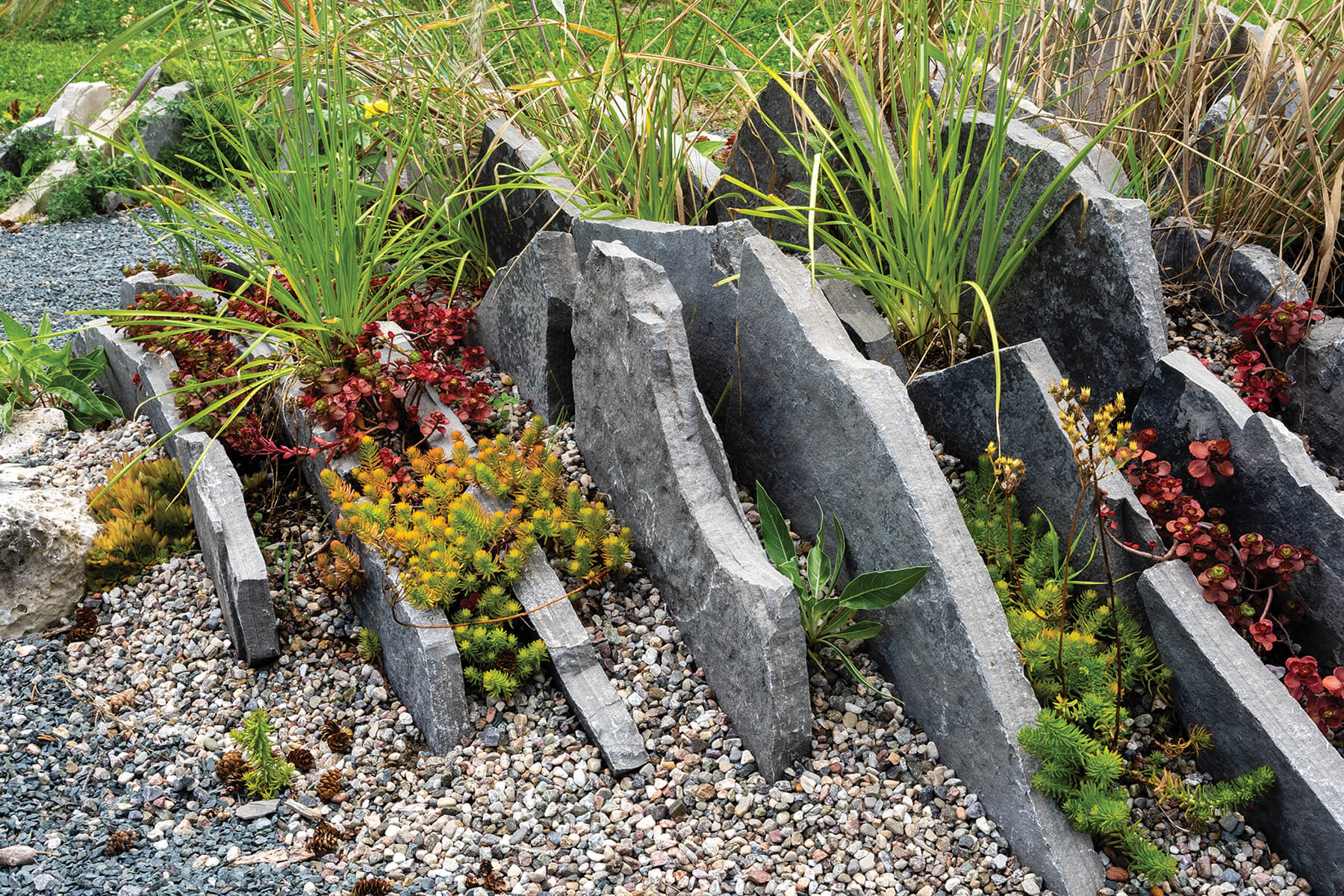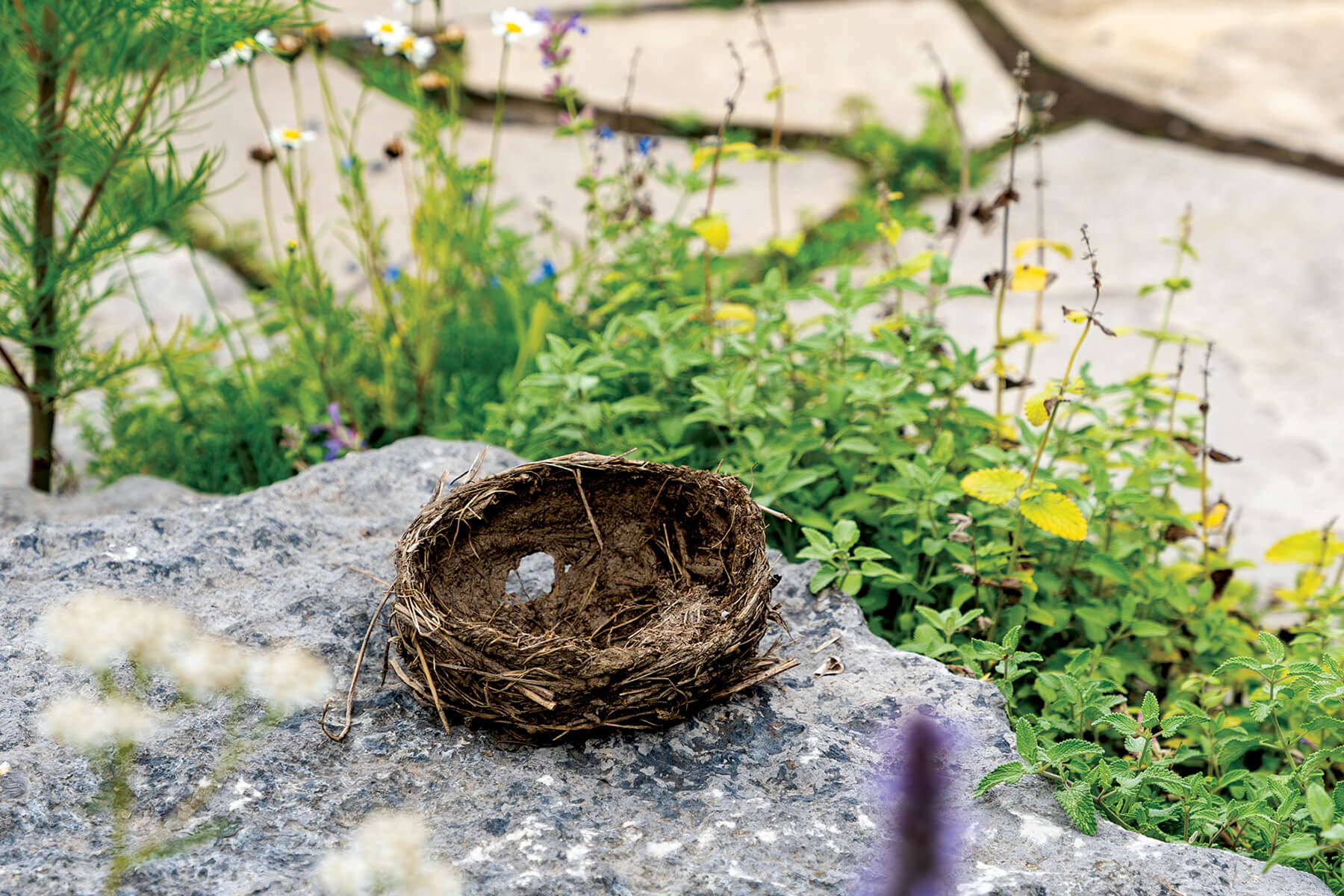November 8, 2022
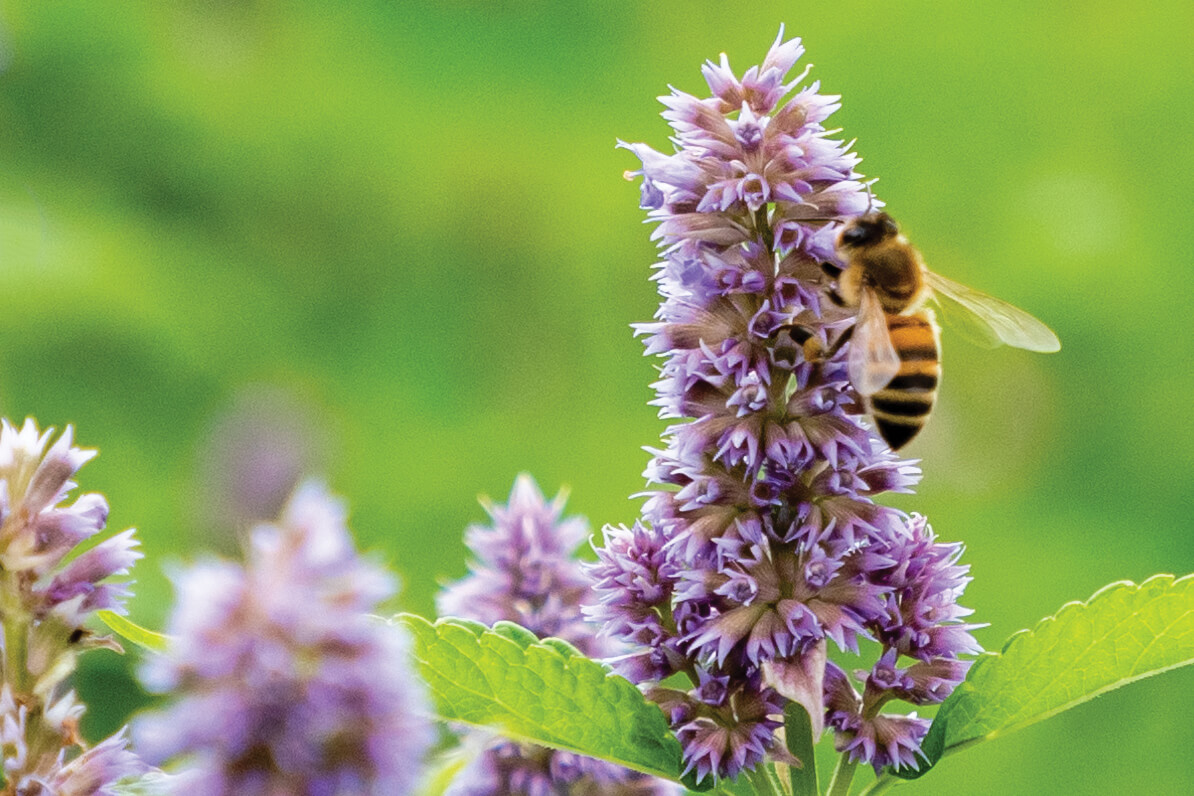
Peace in a bee-loud glade
By Karina Sinclair
At the end of a tree-lined gravel driveway, I come upon a quiet riot of colour; blooms of blush pink, mauve, gold and green drifting together — a watercolour painting come to life. Tall, stately grasses lean with the whisper of a breeze. A low hum of happiness transports me to the bee-loud glade from a favourite W.B. Yeats poem. I hear a bright trill ring out from a nearby tree, and the answering call is met with a swooping flash of yellow; goldfinches have found a home here. The kerplunk of nearby water reveals that frogs have too. This haven of wildlife is the work of landscape designer Karina Lapierre.
Lapierre’s business, Lavish Gardens, specializes in creating and installing naturalistic gardens, designed to invite biodiversity, showcase native plants, and create a deep level of serenity. Lapierre’s journey in landscaping has been an evolution. She started Lavish Gardens in Toronto in 2008, eventually moving to Stirling, Ont., where the landscapes were bigger and surrounded by rolling, pastoral views. She was installing hardscapes — brick patios, walkways and stone retaining walls — and one day asked herself if that’s what she wanted to do for the rest of her life.
“I slowly became conscious of the more ecological aspects of landscaping, and started installing some meadow gardens, wildflower gardens, and became more conscious of pollinators,” Lapierre said. “And that’s when I really fell in love with my profession and decided to start a more ecologically minded company to give more options to our clients in terms of sustainability.”
Now, Lavish Gardens is renowned for its ecological approach. In addition to meadows, their services include the design, installation, and maintenance of streams, waterfalls, swim ponds and lawn alternatives. They also offer pond remediation and the rewilding of newly developed areas.
At the end of a tree-lined gravel driveway, I come upon a quiet riot of colour; blooms of blush pink, mauve, gold and green drifting together — a watercolour painting come to life. Tall, stately grasses lean with the whisper of a breeze. A low hum of happiness transports me to the bee-loud glade from a favourite W.B. Yeats poem. I hear a bright trill ring out from a nearby tree, and the answering call is met with a swooping flash of yellow; goldfinches have found a home here. The kerplunk of nearby water reveals that frogs have too. This haven of wildlife is the work of landscape designer Karina Lapierre.
Lapierre’s business, Lavish Gardens, specializes in creating and installing naturalistic gardens, designed to invite biodiversity, showcase native plants, and create a deep level of serenity. Lapierre’s journey in landscaping has been an evolution. She started Lavish Gardens in Toronto in 2008, eventually moving to Stirling, Ont., where the landscapes were bigger and surrounded by rolling, pastoral views. She was installing hardscapes — brick patios, walkways and stone retaining walls — and one day asked herself if that’s what she wanted to do for the rest of her life.
“I slowly became conscious of the more ecological aspects of landscaping, and started installing some meadow gardens, wildflower gardens, and became more conscious of pollinators,” Lapierre said. “And that’s when I really fell in love with my profession and decided to start a more ecologically minded company to give more options to our clients in terms of sustainability.”
Now, Lavish Gardens is renowned for its ecological approach. In addition to meadows, their services include the design, installation, and maintenance of streams, waterfalls, swim ponds and lawn alternatives. They also offer pond remediation and the rewilding of newly developed areas.
 Karina Lapierre, Owner/Designer of Lavish Gardens.
Karina Lapierre, Owner/Designer of Lavish Gardens.
Flora and fauna first
As she guided me through her award-winning Stonehouse Wildflower Meadow project, Lapierre shared that she wanted to know as many plants as possible, especially native plants, to understand how they perform in landscapes. That understanding shifted her focus toward designing sustainable landscapes.“When I realized that native plants have such a capacity to improve the ecosystem that surrounds us and improve the potential food sources for wildlife, such as pollinators, butterflies, bees, birds, it really made me connect with the profession a lot deeper,” Lapierre said. As we strolled the meadow paths together, coneflowers and goldenrod bobbed their showy heads and Lapierre gently grazed them with her fingertips. It seemed a silent communication, as if each were demonstrating their affection for one another.
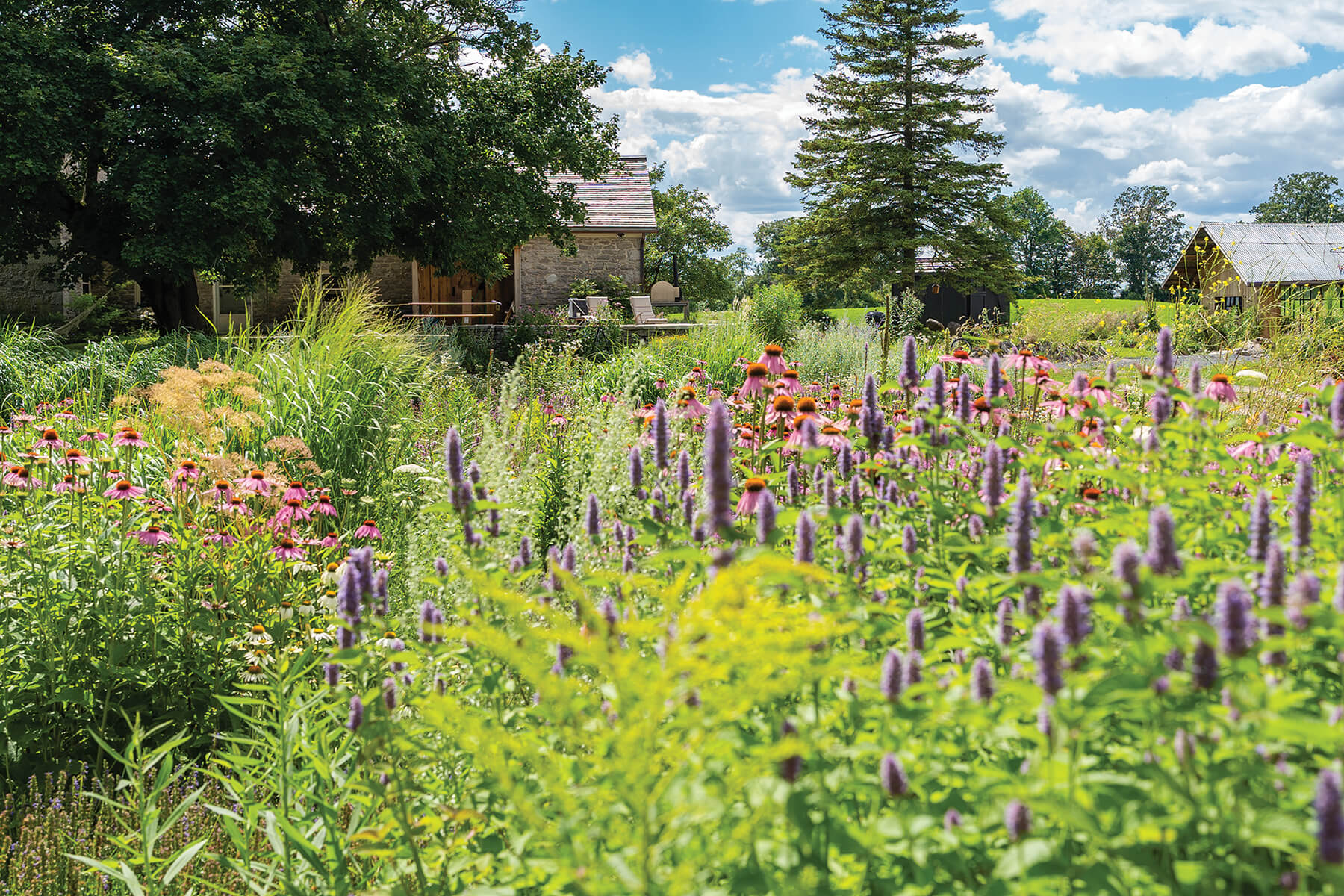 Award-winning Stonehouse Wildflower Meadow in Stirling, Ont.
Award-winning Stonehouse Wildflower Meadow in Stirling, Ont.
In pursuit of childlike wonder
To pursue this more natural direction, Lapierre decided to define her business’s purpose and mission by asking herself why she and her fellow landscapers do what they do. At first, the answer was simply because they love being outside and being in touch with the seasons. Upon further reflection, Lapierre realized they love being outside because it reminds them of being children.“When you’re outside as a child, you really notice all those little things, like all the insects and the little animals and the frogs and the birds and how a blade of grass feels in your fingers or in your mouth,” Lapierre said. “When you develop these really biodiverse gardens, you’re constantly in contact with the life that inhabits them. And that’s really our purpose and our mission with our business.”
Lapierre believes it takes a special person to be a landscaper; someone who is willing to work hard, be passionate, and cope with the seasonality of the job. She describes landscaping as sometimes unforgiving and feels it’s important to hire people who can find the pleasure and the beauty in the work.
“I’m looking for people that are interested in nature, that feel validated at the end of a project; that are just mesmerized by the opportunity they got to create these kinds of gardens or to build these kinds of water features,” Lapierre said. “Every year, year on end, our sales are always increasing. People are getting to know our unique qualities. We’re starting to attract real talent, which has been wonderful for me because in the industry we all know how difficult it’s been to try to find good hires.”
She credits Landscape Ontario for boosting the skills and profile of professional landscapers. “I think for many, many years, landscapers had a bad reputation. And Landscape Ontario has brought everybody together and really focused on training and the professional aspects of the business,” she said. “And I myself have taken lots of training courses through Landscape Ontario in the winter on landscaping techniques or even how to run a business better. It’s really helped me to become a better business owner.”
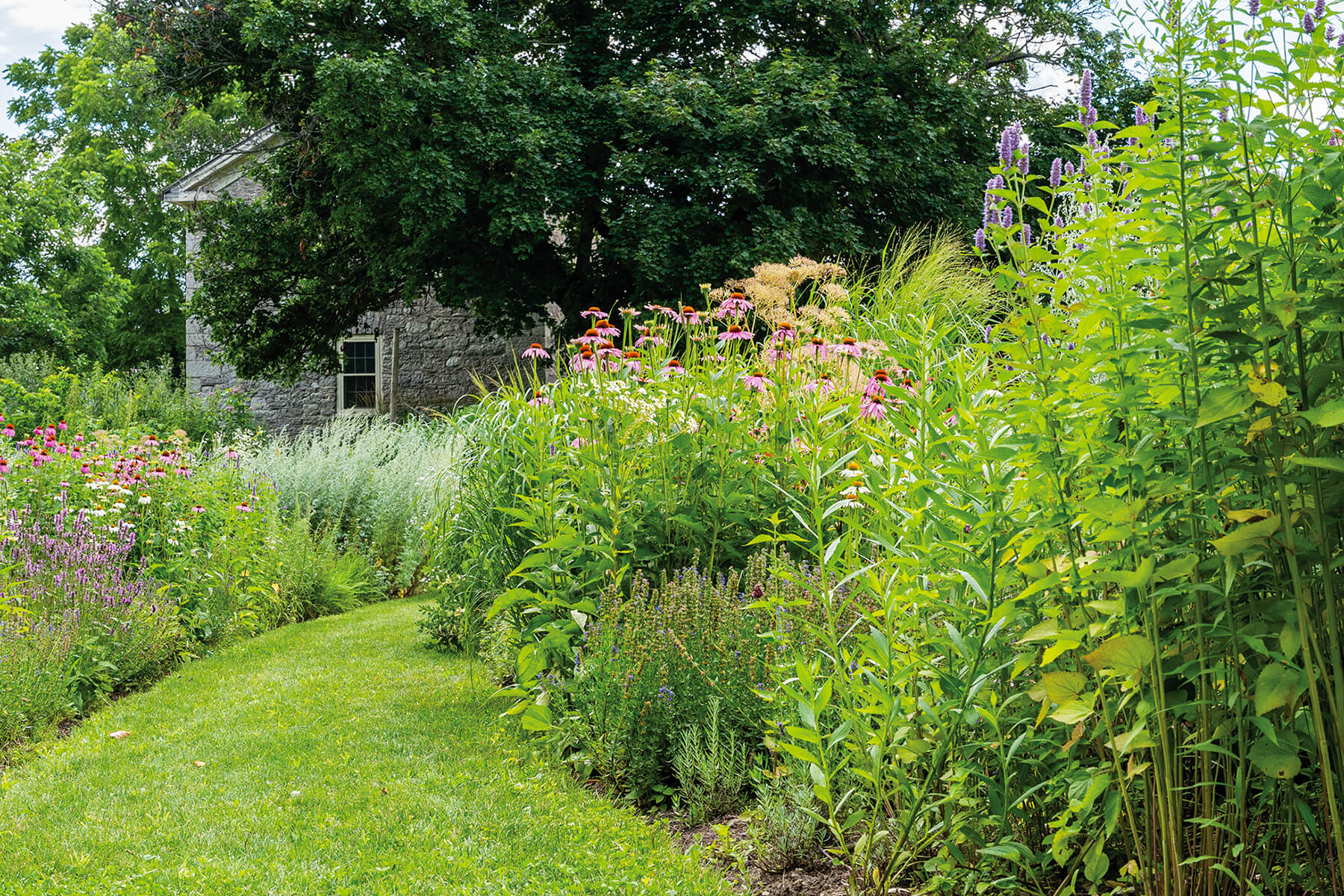 Grassy paths meander through the meadow, providing space for the homeowner's children to experience the garden up close.
Grassy paths meander through the meadow, providing space for the homeowner's children to experience the garden up close.
Room in the ecosystem for all
Lapierre has noticed more homeowners are seeking to create an experience in their landscapes, and that they’re also concerned about the environment and the health of pollinators. The meadows, natural swim ponds, and waterfalls that Lavish Gardens installs resonate with people.“People call us because we’re us,” Lapierre said. “They don’t call us to get a competitive quote with another landscaper. There are quite a few landscapers in Ontario that are nature focused or ecologically focused. But in this area, there are not a lot of other companies that have the same mindset that we do. And so people call us specifically for being Lavish Gardens.”
There’s plenty of room for more landscapers to offer similar services, though. Lapierre would love to see more of her peers focus on increasing biodiversity. She suggests, “You have to kind of immerse yourself in the study of the local ecology, of the local environment.” Lapierre will admit this isn’t for everyone, but invites landscapers and homeowners to consider it because: “It brings so much joy not only to myself, to our clients, to our staff, but also for the ecosystems around us.”
 Native flowers, like bee balm or wild bergamot, provides a feast for pollinators.
Native flowers, like bee balm or wild bergamot, provides a feast for pollinators.
Green Stamp Award
Giving special attention to the environment has earned Lavish Gardens some accolades as well. The Stonehouse Wildflower Meadow, the very landscape surrounding Lapierre and I in dreamy colour and texture, won a Green Stamp Award in Landscape Ontario’s 2022 Awards of Excellence program. The award is given to projects that exemplify green practices, using quality construction, maintenance and design in sustainable landscapes. A field of native grasses, sedges, and flowers currently hosting merry bees, butterflies, and birds, it’s obvious why this project deserved the nod.“When I found out the Stonehouse Meadow won the Green Stamp Award, I was so overjoyed. I had tears in my eyes. Being recognized by your peers for something different that you’re doing is just really fantastic,” Lapierre said. “It makes you feel all grown up, in a sense, but also because the green industry, even though it’s called a green industry, is not always absolutely green. There’s a lot of waste involved in our constructions, our installations. There are a lot of chemicals that are applied to get this picture perfect landscape. And the fact that Landscape Ontario even has a Green Stamp Award is really fantastic and so important in the world that we currently live in.”
Planting the future
Lapierre would love to dispel some misconceptions of native plants and naturalized gardens. “I wish people understood that ‘native plants’ doesn’t necessarily mean weeds,” she said. “Some people think of naturalized gardens as kind of messy and dirty. They might have seen some native gardens that might not have been super artfully installed or maybe they see them at the wrong time in the season.”Compared to a formal garden where every plant is perfectly placed according to height, size and spread, Lapierre insists her installations can feel just as organized. “You can take any plants and arrange them in combinations that will create beautiful juxtapositions. I wish people understood that better.”
As we chat in the mid-June afternoon sun, many of the plants around us stretch as tall as six feet, and Lapierre explained some will nearly double by autumn. “A lot of people think if you use native plants, you have to use purely native plants in order to have a benefit on the environment,” Lapierre said, pointing out some red poppies the homeowners had added to the garden. Their saturated ruby hue stood out brightly amongst the muted pastel tones of the native plants. “I feel that people shouldn’t be afraid to mix their favourite introduced ornamental plants with Ontario wildflowers. Combinations are endless. A lot of the time, the cultivars attract pollinators just as well as a native plant. And if you have biodiversity in your landscape, you will see multiple times per day how that biodiversity is helping the creatures around you.”
We pause together to watch fuzzy bumble bees take delight in the bright purple bee balm, their pollen baskets brimming. The feast has been made possible by Lapierre’s thoughtful installation. “I’ve never been stung,” Lapierre told me when I asked if the bees are a bother while she works. “A lot of people might think it’s going to be dangerous, but we work with them all around us. I guess they do speak to us in a sense, because I feel like on some intrinsic level they must know that we’re helping, that we’re there with them as opposed to there to take them away from the landscape. You just do your thing. Let them do their thing. We’re too busy. They’re too busy. It’s just kind of all works in harmony. We all work in harmony.”
A little farther down the winding path Lapierre plucks a bright green leaf to show me how many plants can engage multiple senses. “This beautiful plant is called anise hyssop and you can make a tea from the leaves that smells like black licorice. The fragrance is incredible.” She inhales the scent before popping it in her mouth. “And it’s delicious!”
 A specialty of Lavish Gardens, this natural swim pond is safe for people and wildlife to enjoy. In the winter, the homeowners ice skate on it.
A specialty of Lavish Gardens, this natural swim pond is safe for people and wildlife to enjoy. In the winter, the homeowners ice skate on it.
Eventually we come to the edge of a five-foot-deep pond. The water is crystal clear thanks to the wetland filtration system Lapierre has incorporated. Water cascades into a small upper pond before trickling into the larger lower basin. Damp footprints fading on the surrounding flagstone suggest we’ve just missed one of the homeowner’s children swimming. A frog basks contentedly on a lilypad. Another blends in with a craggy, moss-covered stone before leaping into the depths, startling the koi. A dragonfly zings past my ear as Lapierre traverses a stone bridge. “Every water feature we create is filled with aquatic organisms instantly,” she said. “Just as every meadow we installed is filled with birds, bees, butterflies, toads, small mammals.”
If you had asked Lapierre in her 20s what she would be doing in her 40s, she would not have imagined she’d be creating purposefully wild spaces. “It’s just been one thing after another that led me to being able to work on these amazing landscapes that I would have never thought of doing. It just happened this way. I really do hope that I leave a legacy with these gardens,” Lapierre said, her gaze following the dancing flight of a Viceroy butterfly. “Hopefully we’re introducing these plants where they don’t exist anymore. We’re hopefully improving the place of pollinators and butterflies as much as we can. And all these gardens and features that we install — like a pond where a child will learn how to swim or learn how to skate on in the winter — that’s a legacy. And it’s just, you know, fantastic to be able to bring nature to people’s homes.”
We wander back to where we started, finding our way around the crevice gardens, past the rescued bird’s nest on the patio and over the herbs embedded between the flagstones. The lowering sun casts long shadows that sweep across the grassy path. In projects like this, Lapierre creates more than pretty landscapes; she creates the space where you can shrug off the weight of the world and just be present as peace comes dropping slow.
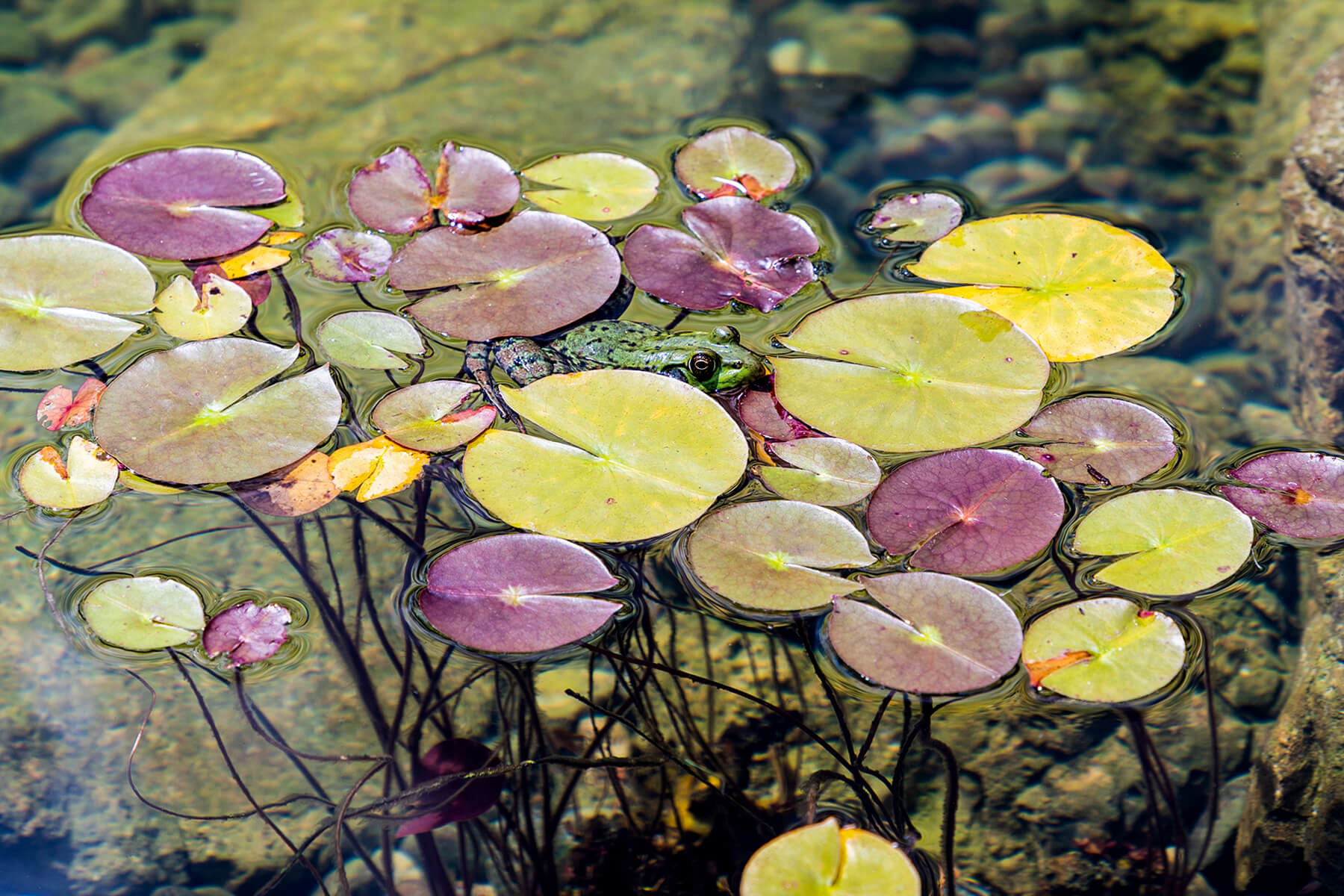 Aquatic plants help keep the pond crystal clear, and create a haven for frogs and dragonflies.
Aquatic plants help keep the pond crystal clear, and create a haven for frogs and dragonflies.

